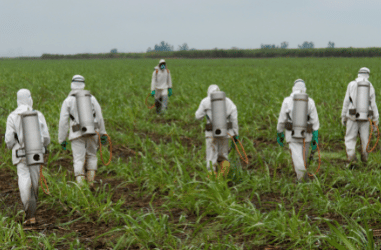Paraquat Poisoning

While it’s possible that Paraquat is an effective weedkiller, this chemical is exceedingly poisonous and should be handled with care. A small dose is sufficient to cause death, according to the American Council on Science and Health. If swallowed, users are exposed to a much higher level of toxicity than other forms of exposure.
According to the Environmental Protection Agency (EPA), all it takes is one sip of this herbicide to be fatal, and over the previous few decades, exposure to Paraquat has been linked to a significant number of fatalities as well as harmful impacts on human health. Recent studies have also found that Paraquat may cause Parkinson’s disease, a debilitating disorder that has a significant negative effect on a person’s quality of life.
In such circumstances, you may be able to file a lawsuit against the Paraquat manufacturer. Your Paraquat attorney may negotiate a settlement with the manufacturer. If you’ve suffered losses due to Paraquat exposure, this settlement could provide you with a reasonable payout to make up for those losses.
Paraquat Poisoning: Clinical Features and Immediate General Management
Paraquat poisoning is currently more commonly caused by self-intoxication with parasuicidal or suicidal intent rather than by accidental intake. There is less likelihood of paraquat poisoning from careless handling during occupational use. However, although Paraquat can penetrate the skin if handled incorrectly, poisoning generally occurs due to ingestion, with rare cases of poisoning after intravenous, subcutaneous, or intraperitoneal injection.
Clinically, there are three degrees of intoxication: mild poisoning, moderate to severe poisoning, and acute fulminant poisoning (sudden and intense poisoning, leading to death):
Mild Poisoning
In cases of mild poisoning, patients exhibit either no symptoms or symptoms that are limited to the gastrointestinal system. This occurs with an injection of less than 20 mg of paraquat ion/kg body weight. Most patients recover without any complications.
Moderate to Severe Poisoning
For moderate to severe poisoning, 20-40 mg of paraquat ion/kg of body weight is normally consumed. Symptoms include renal failure and pulmonary fibrosis, which may not emerge for days or weeks. These may be preceded by non-specific symptoms of ill health and local gastrointestinal problems. For most patients, death comes after two to three weeks.
Acute Fulminant Poisoning
This occurs with an injection of 40 mg of paraquat ion/kg body weight. Patients will typically be unconscious or comatose at this stage and have a fixed gaze. They may show signs of peripheral circulatory collapse such as a pale appearance and cool extremities. Gasping respirations are likely to be present at first before progressing to respiratory arrest or death due to respiratory failure.
Treatment of Paraquat poisoning involves activated charcoal if there are signs of aspiration. Activated charcoal can cause a significant reduction in toxin absorption from the gut into the bloodstream. A doctor would replace the fluid loss, determine the plasma paraquat concentration, relieve symptoms, and provide supportive care for terminally ill patients.
However, Paraquat poisoning in the terminally sick presents an even larger clinical challenge to medical and nursing skills than merely using ways to prevent absorption or increase elimination of Paraquat.
Paraquat Poisoning: Survival after Oral Ingestion
Survival after swallowing Paraquat depends on the route and degree of absorption. It also depends on treatment options, although there is no prescribed way of treating Paraquat poisoning. Prompt treatment with activated charcoal, diatomaceous earth (used to prevent lumps from forming so the poison can be more easily removed), and gastric lavage (sucking the poison out with a tube) may prevent kidney damage. If exposed to Paraquat, call your doctor or emergency services immediately.
Case Presentation
One hour after ingesting 20 ounces of a 50/50 water/paraquat mixture, a 52-year-old Caucasian farmer from South Carolina arrived at the Medical University of South Carolina Health-University Medical Center with nausea and vomiting of blue-colored fluid. A physical examination didn’t show any abnormal signs. There was a plasma level of Paraquat, and the patient was given activated charcoal and sorbitol to flush out toxins from the digestive tract.
The patient was put on Continuous Venous Hemofiltration (CVVH) right away using a hemoperfusion charcoal filter. However, the filter clogged dialysis, and the dialysis was stopped. The hemoperfusion filter was then removed before CVVH began. On the second day, the patient’s creatinine (Cr) level had risen to 2.1 mg/dl from 1.1 mg/dl. The client was put on Cyclophosphamide 200 mg IV daily for two days and methylprednisolone 1 g daily for three days.
Despite CVVH, the patient’s Cr climbed to 3.4 mg/dl on day three of the hospitalization, and he thereafter had blood-tinged sputum, nausea, and vomiting. The results of a chest radiograph revealed fresh alveolar infiltrates. He needed two liters of oxygen per minute when his oxygen saturation dropped to 93 percent. Charcoal hemoperfusion was initiated after an arterial blood gas revealed a PaO2 of 70.
The patient’s condition worsened on day five with increasing dyspnea, hypoxemia, and basilar crackles on lung examination. He was put on Dexamethasone 5 mg IV every 6 hours. After 6 days of therapy with CVVH and a Cr plateau of 2.5 mg/dl, the patient’s paraquat level was discovered to be 0.034 mg/mL, which is very good for survival. He was then put on Dexamethasone tapering.
The patient subsequently recovered after receiving a mental assessment, care, and therapy. After receiving intense psychiatric care connected to his suicide attempt, he was released after 21 days in the hospital.
Discussion
Paraquat poisoning is a serious problem in the United States and abroad. It is used for weed and grass control, available as a liquid in various strengths. Recently, however, deliberate self-poisoning with pesticides such as Paraquat has become a significant threat to public health.
Paraquat poisoning usually occurs after ingestion and is less likely to cause harm when correctly applied to weeds or other vegetation.
In the U.S., Paraquat has “restricted use” and can only be used by licensed applicators who must follow strict guidelines. Since Paraquat is highly toxic, the form marketed in the United States contains security features including an emetic agent (induces vomiting), sharp odor, and blue dye.
Discussion: Clinical Course
Based on the above case study, the level of Paraquat in the blood seems to directly affect whether a patient will die from paraquat poisoning. Plasma values of more than 0.2 mg/mL at 24 hours and 0.1 mg/mL at 48 hours after consumption are often linked to death. Gas chromatography (1 microgram/mL) and radioimmunoassay (0.1 microgram/mL) are two laboratory tests that may detect paraquat quantities of 1 mg/mL or more in urine. Regarding exposure modalities, the fatality possibility ranks from ingestion, inhalation, and intravenous as the least.
Organ failure in Paraquat poisoning cases is said to be caused by the formation of oxygen free radicals, which oxidize NADPH, resulting in cell death. Lung toxicity from Paraquat poisoning, which results in pulmonary fibrosis and respiratory failure, is the most damaging clinical outcome. Fatal respiratory failure after swallowing Paraquat is caused by fibrosis, which often appears days to weeks after ingestion since the toxins mostly stay in the lungs.
Additionally, as the kidneys are the main organs responsible for excreting Paraquat, acute tubular necrosis may develop shortly after consumption, resulting in reduced excretion of the chemical and increasing the toxicity. Since the patient experienced Acute Renal Failure (ARF) on the very first day after admission, the doctors were worried about the quantity of Paraquat ingested and increased toxicity due to poor Paraquat excretion.
Treatment
There are presently no official protocols for treating Paraquat poisoning. Treatment options include GI absorption prevention, elimination of Paraquat from the blood, and therapy treatments such as antioxidants and immunotherapy.
Prevention of Absorption
GI absorption prevention is usually treated as an intervention in patients who arrive quickly after consumption. A doctor may use activated charcoal, diatomaceous earth, or gastric lavage. However, there is no evidence that gastric lavage and activated charcoal have any positive effects. Treatments to limit Paraquat absorption should be implemented based on the individual situation and take into account the likely amount of Paraquat taken and how long ago it was swallowed.
Removal of Paraquat From the Blood
Paraquat poisoning can occur when someone attempts suicide by swallowing Paraquat. Ingestion in high doses can be fatal or cause severe health problems if it is not removed from the blood.
There are three ways to remove Paraquat poison from the blood, including Hemoperfusion (HP), Hemodialysis (HD), and Continuous Venous Hemofiltration. It is generally believed that removing Paraquat from blood circulation with hemoperfusion is more effective than hemodialysis and that using hemoperfusion within 12 hours after exposure may reduce mortality significantly.
CVVH may enhance survival, minimize organ dysfunction, and allow patients more time to receive additional treatment. Studies show that patients who received early hemoperfusion had a higher chance of survival than those who did not. However, when hemodialysis or hemoperfusion was performed alone or in combination, there were no consistent successful outcomes. Nonetheless, it’s recommended that a doctor commences early hemodialysis or hemoperfusion for up to 6 hours daily. Also, therapy may be necessary for at least 2 to 3 weeks after accessing the poison levels in the blood.
Alternative Therapies
In addition to immunosuppression and antioxidant therapy, there are several other approaches to treating acute Paraquat poisoning. Patients who received antioxidant or immunosuppressive therapy in addition to hemoperfusion had better survival rates than those who received hemoperfusion alone, according to a recent systematic review with meta-analysis.
Additionally, until the PaO2 (the level of oxygen pressure in the blood) is less than 50, oxygen therapy should be restricted in cases of acute Paraquat poisoning to prevent the generation of oxygen free radicals and further organ damage.
Another therapy is immunosuppressive therapy. Although its efficacy has been disputed, it appears to be the most effective treatment for Paraquat poisoning. Paraquat poisoning is expected to limit the amount of oxygen free radicals introduced into the body by immunosuppressants, even if the way it happens is unclear.
For example, cyclophosphamide (5 mg/kg/d) and dexamethasone (24 mg/d) were given to 72 patients for two weeks, and their survival rate was found to be 75 percent. However, a subsequent study found that this strategy was ineffective.
When given cyclophosphamide, methylprednisolone, and dexamethasone, patients with moderate Paraquat poisoning had a lower mortality rate than those who received only dexamethasone. However, a Cochrane Review of patients with moderate to severe paraquat poisoning found that those who received glucocorticoids and cyclophosphamide also experienced reduced death rates.
The use of antioxidants such as acetylcysteine, deferoxamine, and Vitamin C is not recommended based on insufficient evidence supporting them. However, the use of acetylcysteine for renal protection prior to imaging could be safe. Because of its mild toxicity profile, it can be used to treat Paraquat poisoning, as it restores glutathione stores and may reduce the generation of free radicals. In Paraquat poisoning patients, high-dose long-term antioxidants may increase the PaO2, minimize lung fibrosis, improve liver function and reduce the chances of lung failure.
Conclusion
It’s true that Paraquat poisoning is fatal due to its ability to cause death. Unfortunately, no official recommendations exist for treating Paraquat toxicity. Only early therapy with gastrointestinal lavage, charcoal, and diatomaceous earth may reduce paraquat absorption. Hemoperfusion, hemodialysis and CVVH can reduce Paraquat levels in the blood.
A health care professional may also use immunosuppressants and antioxidants as alternative treatments for Paraquat toxicity, as they’ve helped in the past. If our patient didn’t recover after CVVH or had higher paraquat levels, immunosuppressant or antioxidant therapy may have been started. Health care professionals can help reduce Paraquat poisoning morbidity and mortality by knowing its clinical presentation, examination, and treatment choices.
If you suspect Paraquat exposure, we have a network of paraquat exposure lawsuit lawyers who can help. They can assist you in identifying the source of exposure and represent you against Paraquat’s manufacturers.
